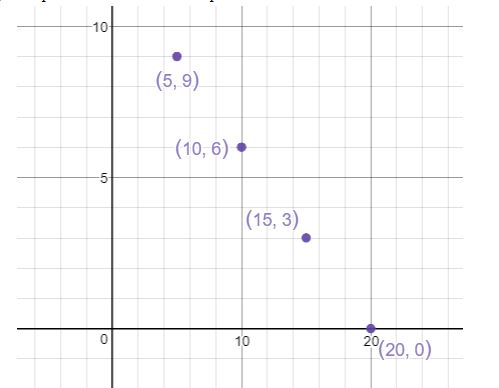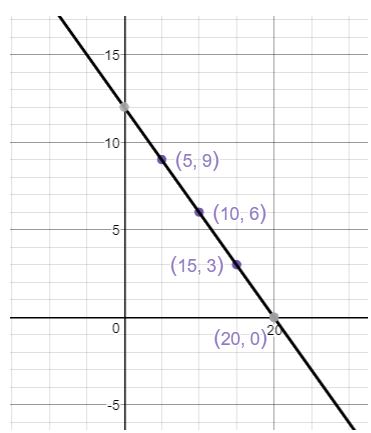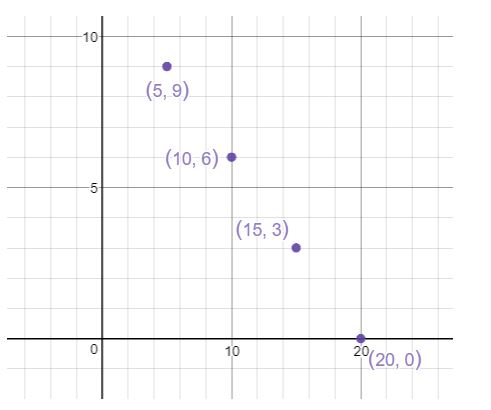
Concept explainers
Developing a Linear Model from Data The following data represent the various combinations of soda and hot dogs that Yolanda can buy at a baseball game with .

a. Plot the ordered pairs in a Cartesian plane.
b. Show that the number of hot dogs purchased is a linear function of the number of sodas purchased .
c. Determine the linear function that describes the relation between and .
d. What is the implied domain of the linear function?
e. Graph the linear function in the Cartesian plane drawn in part (a).
f. Interpret the slope.
g. Interpret the values of the intercepts.
To calculate:
a. Plot the ordered pairs in a Cartesian plane.
b. Show that the number of hot dogs purchased is a linear function of the number of sodas purchased .
c. Determine the linear function that describes the relation between and .
d. What is the implied domain of the linear function?
e. Graph the linear function in the Cartesian plane drawn in part (a..
f. Interpret the slope.
g. Interpret the values of the intercepts.
Answer to Problem 52AYU
Solution:
a. The plot of the data in Cartesian plane is as shown below:

b. Yes, it is proved that the number of hot dogs purchased is a linear function of the number of sodas purchased .
c. The linear function of the given data is .
d. The implied domain of the given function is .
e. The graph is as shown below:

f. The function is an decreasing function.
g. Therefore, the is 12 and is 20.
Explanation of Solution
Given:
The given data is

Formula Used:
Average rate of change if a function from to is .
Point slope formula:
Calculation:
a. The plot of the given data in a Cartesian plane is

b. Here, in the above Cartesian plane, we can see that the points are arranged in a straight line format.
On joining the given points, we get a straight non vertical line.
Therefore, we can say that the given number of hot dogs purchased is a linear function of number of sodas purchased .
c. From the given data, we can find the average rate of change.
When
Now, we get the average rate of change of the given function as
Thus, the rate of change of the given function is .
Now, we have to use this in the point slope formula, where and .
Thus, we get
Therefore, the linear function of the given data is .
d. We can see that the value of x in the linear function can be any number. Therefore, the implied domain of the given function is .
e. The graph of the linear function is

f. We know that the average rate of change of the function is itself its slope.
Thus, here we have seen that the slope is which is a negative number.
Therefore, the function is an decreasing function.
g. is to be calculated when is equal to zero and intercept is to be calculated when is equal to zero.
From the function , we can calculate the intercepts and intercept.
:
:
Therefore, the is 12 and is 20.
Chapter 3 Solutions
Precalculus Enhanced with Graphing Utilities
Additional Math Textbook Solutions
A Problem Solving Approach To Mathematics For Elementary School Teachers (13th Edition)
Calculus: Early Transcendentals (2nd Edition)
College Algebra with Modeling & Visualization (5th Edition)
Introductory Statistics
University Calculus: Early Transcendentals (4th Edition)
Thinking Mathematically (6th Edition)
- Consider the following system of equations, Ax=b : x+2y+3z - w = 2 2x4z2w = 3 -x+6y+17z7w = 0 -9x-2y+13z7w = -14 a. Find the solution to the system. Write it as a parametric equation. You can use a computer to do the row reduction. b. What is a geometric description of the solution? Explain how you know. c. Write the solution in vector form? d. What is the solution to the homogeneous system, Ax=0?arrow_forward2. Find a matrix A with the following qualities a. A is 3 x 3. b. The matrix A is not lower triangular and is not upper triangular. c. At least one value in each row is not a 1, 2,-1, -2, or 0 d. A is invertible.arrow_forwardFind the exact area inside r=2sin(2\theta ) and outside r=\sqrt(3)arrow_forward
- A 20 foot ladder rests on level ground; its head (top) is against a vertical wall. The bottom of the ladder begins by being 12 feet from the wall but begins moving away at the rate of 0.1 feet per second. At what rate is the top of the ladder slipping down the wall? You may use a calculator.arrow_forwardExplain the focus and reasons for establishment of 12.4.1(root test) and 12.4.2(ratio test)arrow_forwarduse Integration by Parts to derive 12.6.1arrow_forward
- Explain the relationship between 12.3.6, (case A of 12.3.6) and 12.3.7arrow_forwardExplain the key points and reasons for the establishment of 12.3.2(integral Test)arrow_forwardUse 12.4.2 to determine whether the infinite series on the right side of equation 12.6.5, 12.6.6 and 12.6.7 converges for every real number x.arrow_forward
 Calculus: Early TranscendentalsCalculusISBN:9781285741550Author:James StewartPublisher:Cengage Learning
Calculus: Early TranscendentalsCalculusISBN:9781285741550Author:James StewartPublisher:Cengage Learning Thomas' Calculus (14th Edition)CalculusISBN:9780134438986Author:Joel R. Hass, Christopher E. Heil, Maurice D. WeirPublisher:PEARSON
Thomas' Calculus (14th Edition)CalculusISBN:9780134438986Author:Joel R. Hass, Christopher E. Heil, Maurice D. WeirPublisher:PEARSON Calculus: Early Transcendentals (3rd Edition)CalculusISBN:9780134763644Author:William L. Briggs, Lyle Cochran, Bernard Gillett, Eric SchulzPublisher:PEARSON
Calculus: Early Transcendentals (3rd Edition)CalculusISBN:9780134763644Author:William L. Briggs, Lyle Cochran, Bernard Gillett, Eric SchulzPublisher:PEARSON Calculus: Early TranscendentalsCalculusISBN:9781319050740Author:Jon Rogawski, Colin Adams, Robert FranzosaPublisher:W. H. Freeman
Calculus: Early TranscendentalsCalculusISBN:9781319050740Author:Jon Rogawski, Colin Adams, Robert FranzosaPublisher:W. H. Freeman
 Calculus: Early Transcendental FunctionsCalculusISBN:9781337552516Author:Ron Larson, Bruce H. EdwardsPublisher:Cengage Learning
Calculus: Early Transcendental FunctionsCalculusISBN:9781337552516Author:Ron Larson, Bruce H. EdwardsPublisher:Cengage Learning





